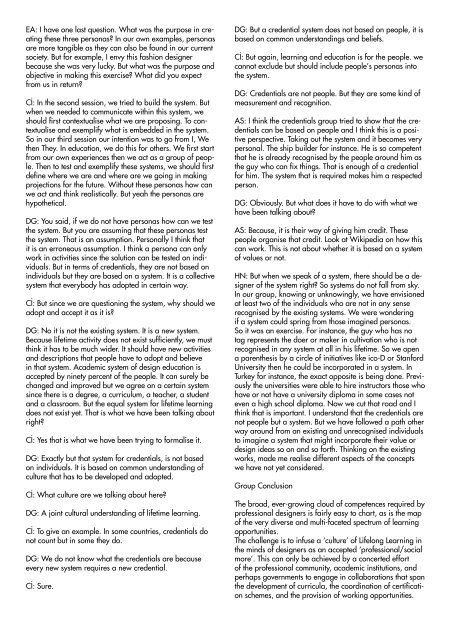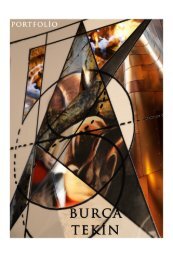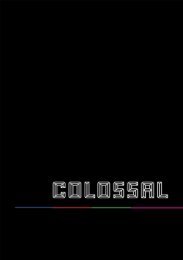BURCA TEKİN - 11535024 -
Create successful ePaper yourself
Turn your PDF publications into a flip-book with our unique Google optimized e-Paper software.
EA: I have one last question. What was the purpose in creating<br />
these three personas? In our own examples, personas<br />
are more tangible as they can also be found in our current<br />
society. But for example, I envy this fashion designer<br />
because she was very lucky. But what was the purpose and<br />
objective in making this exercise? What did you expect<br />
from us in return?<br />
Cİ: In the second session, we tried to build the system. But<br />
when we needed to communicate within this system, we<br />
should first contextualise what we are proposing. To contextualise<br />
and exemplify what is embedded in the system.<br />
So in our third session our intention was to go from I, We<br />
then They. In education, we do this for others. We first start<br />
from our own experiences then we act as a group of people.<br />
Then to test and exemplify these systems, we should first<br />
define where we are and where are we going in making<br />
projections for the future. Without these personas how can<br />
we act and think realistically. But yeah the personas are<br />
hypothetical.<br />
DG: You said, if we do not have personas how can we test<br />
the system. But you are assuming that these personas test<br />
the system. That is an assumption. Personally I think that<br />
it is an erroneous assumption. I think a persona can only<br />
work in activities since the solution can be tested on individuals.<br />
But in terms of credentials, they are not based on<br />
individuals but they are based on a system. It is a collective<br />
system that everybody has adopted in certain way.<br />
Cİ: But since we are questioning the system, why should we<br />
adopt and accept it as it is?<br />
DG: No it is not the existing system. It is a new system.<br />
Because lifetime activity does not exist sufficiently, we must<br />
think it has to be much wider. It should have new activities<br />
and descriptions that people have to adopt and believe<br />
in that system. Academic system of design education is<br />
accepted by ninety percent of the people. It can surely be<br />
changed and improved but we agree on a certain system<br />
since there is a degree, a curriculum, a teacher, a student<br />
and a classroom. But the equal system for lifetime learning<br />
does not exist yet. That is what we have been talking about<br />
right?<br />
Cİ: Yes that is what we have been trying to formalise it.<br />
DG: Exactly but that system for credentials, is not based<br />
on individuals. It is based on common understanding of<br />
culture that has to be developed and adopted.<br />
Cİ: What culture are we talking about here?<br />
DG: A joint cultural understanding of lifetime learning.<br />
Cİ: To give an example. In some countries, credentials do<br />
not count but in some they do.<br />
DG: We do not know what the credentials are because<br />
every new system requires a new credential.<br />
Cİ: Sure.<br />
DG: But a credential system does not based on people, it is<br />
based on common understandings and beliefs.<br />
Cİ: But again, learning and education is for the people. we<br />
cannot exclude but should include people’s personas into<br />
the system.<br />
DG: Credentials are not people. But they are some kind of<br />
measurement and recognition.<br />
AS: I think the credentials group tried to show that the credentials<br />
can be based on people and I think this is a positive<br />
perspective. Taking out the system and it becomes very<br />
personal. The ship builder for instance. He is so competent<br />
that he is already recognised by the people around him as<br />
the guy who can fix things. That is enough of a credential<br />
for him. The system that is required makes him a respected<br />
person.<br />
DG: Obviously. But what does it have to do with what we<br />
have been talking about?<br />
AS: Because, it is their way of giving him credit. These<br />
people organise that credit. Look at Wikipedia on how this<br />
can work. This is not about whether it is based on a system<br />
of values or not.<br />
HN: But when we speak of a system, there should be a designer<br />
of the system right? So systems do not fall from sky.<br />
In our group, knowing or unknowingly, we have envisioned<br />
at least two of the individuals who are not in any sense<br />
recognised by the existing systems. We were wondering<br />
if a system could spring from those imagined personas.<br />
So it was an exercise. For instance, the guy who has no<br />
tag represents the doer or maker in cultivation who is not<br />
recognised in any system at all in his lifetime. So we open<br />
a parenthesis by a circle of initiatives like ico-D or Stanford<br />
University then he could be incorporated in a system. In<br />
Turkey for instance, the exact opposite is being done. Previously<br />
the universities were able to hire instructors those who<br />
have or not have a university diploma in some cases not<br />
even a high school diploma. Now we cut that road and I<br />
think that is important. I understand that the credentials are<br />
not people but a system. But we have followed a path other<br />
way around from an existing and unrecognised individuals<br />
to imagine a system that might incorporate their value or<br />
design ideas so on and so forth. Thinking on the existing<br />
works, made me realise different aspects of the concepts<br />
we have not yet considered.<br />
Group Conclusion<br />
The broad, ever-growing cloud of competences required by<br />
professional designers is fairly easy to chart, as is the map<br />
of the very diverse and multi-faceted spectrum of learning<br />
opportunities.<br />
The challenge is to infuse a ‘culture’ of Lifelong Learning in<br />
the minds of designers as an accepted ‘professional/social<br />
more’. This can only be achieved by a concerted effort<br />
of the professional community, academic institutions, and<br />
perhaps governments to engage in collaborations that span<br />
the development of curricula, the coordination of certification<br />
schemes, and the provision of working opportunities.<br />
PLENUM REVIEW & DISCUSSION<br />
Members: Andreas Schneider, Cihangir İstek, David Grosmann,<br />
Halil Nalçaoğlu, Sebastien Shahmiri, Hande Akyıl, Aslı<br />
Kıyak İngin, Harun Ekinoğlu, Cihan Çankaya, Ebru Erarslan,<br />
Ayhan Fişekçi<br />
Andreas Schneider (AS): We are aware that this workshop<br />
might have been created some sort of a separation between<br />
each of the three different tracks. We aimed to overreach<br />
that through the presentations and the rotation of the groups<br />
which injected thoughts to their new groups from the previous<br />
discussions. But today, I think it is time to discuss about what<br />
the moderators and participants experience of yesterday. We<br />
will try to see how we can connect these three tracks in terms<br />
of producing that document, which we regard as a starting<br />
point or seed for the proposal that we talked about at the<br />
beginning of the workshop for the submission to the World<br />
Design Summit in Montreal. This proposal will be a manifesto<br />
or an agenda of what the format and content of lifelong learning<br />
could be. So, the purpose of today’s session is to extract<br />
a conclusion from yesterday’s experience and insights.<br />
Cihangir İstek (Cİ): For example, one of the questions raised<br />
yesterday was why we had the third session where we asked<br />
you to think of the three possible personas or users. What we<br />
expect for you to produce is to create possible user-scenarios.<br />
We even tried to diagram these scenarios in our previous<br />
workshops because, using and configuring user-scenarios<br />
always makes more sense when we try to explain our models<br />
to the third parties. This is one of the methods of how we aim<br />
to compile the proposal. As we all were experiencing during<br />
yesterday’s workshop, it is always difficult when we are participating<br />
in a very tightly scheduled event like this, and that<br />
we might indeed easily lose the whole picture. But, once it is<br />
finished and we look back on what was configured, hopefully<br />
it will all make more sense.<br />
AS: I do not know if this is relevant, but some people also<br />
questioned why it is three in general. Why not four? Some<br />
people might have thought that this is like a game or a<br />
formalistic exercise. There is however a reason why we use<br />
‘three’ as a core element or inspiration from the way we look<br />
at if we think we have a sort of non-binary principle like a<br />
yes-or-no issue. We use our factors on the issues that cannot<br />
be captured by binary principle because, when we have more<br />
than three, we will always have more elements which are not<br />
in contact with other elements. Number three is used in order<br />
to achieve any of the thoughts, issues or dimensions which are<br />
connected or integrated with each other, which also makes<br />
sure that every element has some connections with each other.<br />
For example, the layout of our three core issues competences,<br />
credentials and actions could well be perceived as a sequence<br />
or even as a hierarchy. Such as competences coming first,<br />
followed by credentials and actions. This is not how we think<br />
and it is very difficult to communicate with a fixed two-dimensional<br />
surface. So, I guess in this morning’s discussion we will<br />
all have a chance and opportunity to reconnect what might<br />
have been perceived as an isolated discussion and discuss it<br />
together in one context.<br />
That would be our expectation from today. I am guessing<br />
that this will also be your own expectation because,<br />
just by looking at our previous stuff some of you<br />
might have felt that, we would need to be more connected.<br />
I suggest to start with what did you take from<br />
yesterday or what could be relevant for the next steps in<br />
terms of lifelong learning.<br />
Ayhan Fişekçi (AF): Firstly, I started to the workshop<br />
within the credentials group but in fact, I believe that<br />
the starting point should be the competences. These<br />
credentials and competences need to be dealt as a<br />
set. Because, credentials in particular are meant to be<br />
upgrading competences to the next level(s). After that,<br />
actions should be introduced to the lifelong learning<br />
system. Secondly, I also think we should have defined<br />
more clear competences for specific action plans. The<br />
ones stated during the workshop are not so specific and<br />
understandable to everyone, such as a clear competences-set<br />
defined for specific learning actions. The<br />
most important part is the beginning. The process we<br />
experienced yesterday was, however, very creative and<br />
brainstorming alike. Today, I hope we can use a more<br />
specific approach, with which we will get to a better<br />
output.<br />
AS: You said that competences are not so clear and<br />
maybe there should be more other competences. Can<br />
you make some suggestions?<br />
AF: Yesterday, I shared with my fellow team members<br />
in the competences team an exemplar tool/set of 18<br />
particular competences used in business leadership, including<br />
‘Technical Skills’, ‘Interpersonal Skills’, ‘Self-confidence’,<br />
‘This-is-it! Skill, ‘Logical Approach’, ‘Practical<br />
Problem-Solving’. Additional competences could also<br />
be added into this set to upgrade for any required performances,<br />
and each skill or competence area would<br />
be detailed into further strengths. For example, in order<br />
to develop technical skills, it is said that one would<br />
be requiring the strengths like ‘Technical Know-how’,<br />
‘Understanding of Subject Matter’ and ‘Flair for Dealing<br />
with Complex Technical Problems’. Another advantage<br />
of having the similar kind of competence set is that if<br />
someone has overplayed on some of the competences,<br />
we could easily track that person as a specialist rather<br />
than a manager, which means that someone lacking of<br />
commercial perspective would be considered as being<br />
one-dimensional, i.e. too technical-focussed, etc. I think,<br />
if we could manage to define a specific competences set<br />
for designers, it would be much more clear for everybody<br />
to understand, as well as much easier to draw<br />
credentials and action plans accordingly.<br />
AS: I wonder if any of our moderator would pick something<br />
from this and continue this discussion by telling<br />
us their own experience of the workshop. Sebastian,<br />
from your own point of view, how did you experience<br />
yesterday? What did you take from the presentations as<br />
a conclusion or insight, and how could that lead to the<br />
content of the documentation?






